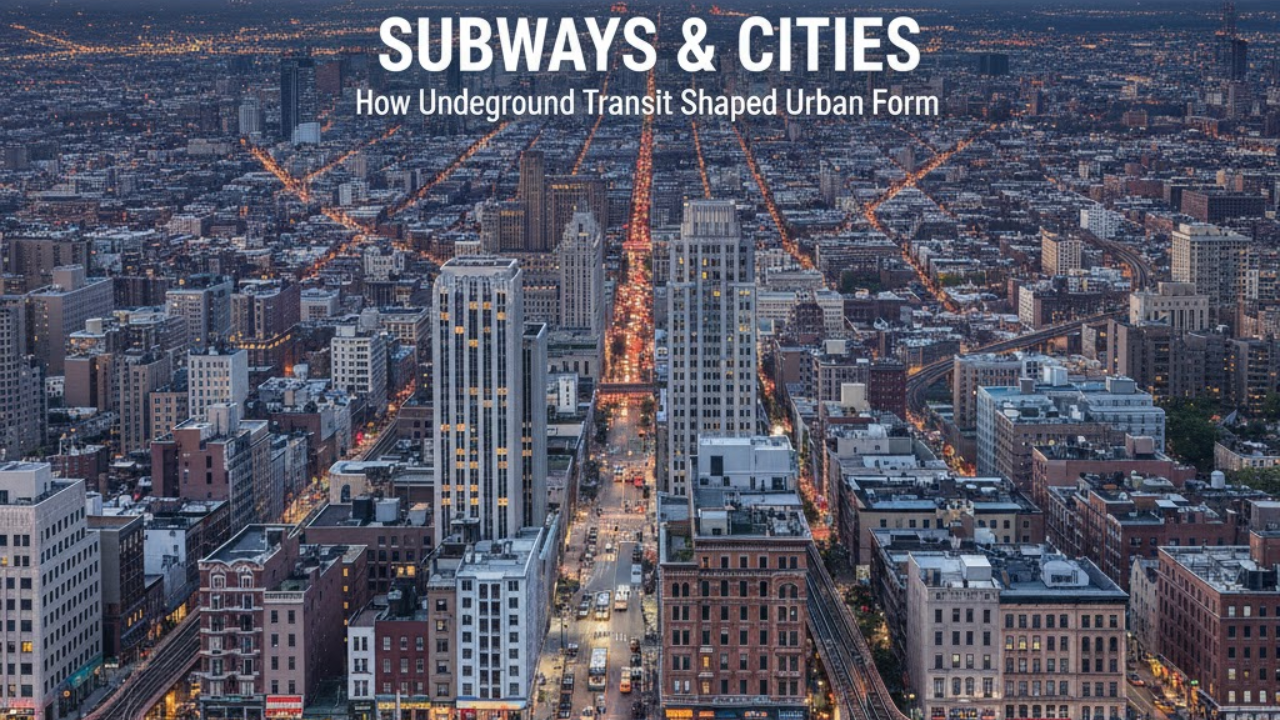
Post by : Meena Rani
Walk through any major city with a subway, and you’ll sense the transformation. Beneath the streets, steel tunnels carve paths for millions; above them, skylines and city blocks adjust to accommodate stations, escalators, foot traffic. Subways didn’t just move people—they reshaped the very bones of modern urban life.
Cities in the late 19th and early 20th centuries were choking in congestion. Horses, trams, carriages, early buses—every street was clogged. Subways (or metros) offered a solution: mass transit out of sight, under the surface. This freed up streets, reduced conflicts with pedestrians, and allowed high-volume transit routes that weren’t constrained by above-ground obstacles.
One of the clearest effects of subway networks is how areas close to stations tend to become more built-up. Residential towers, mixed-use developments, offices, shopping districts often cluster near key subway stops. The subway acts like a spine: people want to live close to easy access, so value and development rise around those nodes.
Recent studies show that when subway systems grow, the spatial layout of the city changes—development spreads out in all directions, sometimes relaxing overly centralized density. Subways enable more decentralized growth while still maintaining connectivity. This helps reduce commuting times and distribute pressure on central business districts. Evidence suggests that expanding subway network length tends to increase subway ridership by roughly 6% for each 10% growth in network scale in many large cities. (Data-driven research supports that effect.)
With subways, fewer people need to rely on cars for daily travel. That means less traffic congestion, lower tailpipe emissions, improved air quality, and quieter streets. Subways tend to be more energy-efficient per passenger kilometer, especially with modern electric systems and regenerative braking. Cities that prioritise subway expansion often report reductions in private vehicle use and an uptick in sustainable transport habits.
A well-designed subway network connects formerly isolated neighborhoods to economic opportunities, schools, healthcare, and entertainment. People who once lived far from jobs or essential services suddenly find the city more accessible. This can reduce inequality—though it is not automatic, and often depends on how affordable the fares are and how well the rest of transit (buses, walking, cycling) connects to subway lines.
Subway stations tend to act like magnets for real estate investment. The value of property near stations often rises, sometimes significantly. The presence of a station changes land use: greenfield plots become housing or mixed-use; low rise becomes vertical; commercial zones emerge. The network centrality of stations (how well connected a station is to many lines or nodes) influences how much value gets capitalized by the surrounding area.
Interestingly, subways don’t always make cities denser only in the center. Some research suggests that subway networks encourage decentralization: as transit access improves across the city, people choose to live farther out, but still enjoy fast commutes. This can lessen pressure on the core, reduce overcrowding, and promote more balanced city growth.
Of course, there are trade-offs. Building subway lines is expensive, disruptive during construction, and requires major upfront investment. Older systems may strain with high maintenance costs. Also, subway expansion can sometimes lead to gentrification: rising property values near stations can push lower-income households out. Planners must design policies to mitigate displacement and ensure equitable access.
Environmental costs are real too: tunnel digging, energy for ventilating underground spaces, materials. Yet many modern projects emphasise sustainability, energy recovery, and greener designs.
Some of the key trends shaping the next generation of subways:
Transit-Oriented Development (TOD): Mixed-use, walkable neighbourhoods built around stations.
Integration with multimodal transport: Bike share, pedestrian zones, feeder-bus networks to enhance last-mile connectivity.
Smart systems: Real-time data, predictive maintenance, energy efficiency, cleaner ventilation and lighting.
Expansion in rapidly urbanizing regions: Asia, Latin America, Africa are building massive metro networks to keep up with population growth.
Subways will keep shaping cities—not just physically but socially and environmentally.
A study of hundreds of cities showed that increasing a city’s subway network tends to drive decentralization, though the effect is smaller than that caused by highways. Urban population growth is less affected by subways than by other factors.
Another recent case: Delhi’s metro expansion triggered measurable land use and land cover changes in zones around stations. Open land became built-up, though concerns around loss of green space and displacement are real.
The shape of a city influences quality of life—how long people commute, how much time they spend with family, how healthy the air is, how energetic and inclusive the city feels. Subways, more than many other infrastructure systems, have the power to alter that shape in profound ways. They enable sustainability, help manage urban sprawl, support livable density, and foster more equitable access.
Disclaimer:
This article is based on research, case studies, and statistical findings current as of mid-2025. Projections and impacts may vary depending on local policy, geography, financing, and societal values. For information and discussion only—not as specific engineering or planning advice.
Subway impact, Urban form, Transit-Oriented Development (TOD), Sustainable Transport, Land Use, Density, Public Transit Growth, City Planning










Advances in Aerospace Technology and Commercial Aviation Recovery
Insights into breakthrough aerospace technologies and commercial aviation’s recovery amid 2025 chall

Defense Modernization and Strategic Spending Trends
Explore key trends in global defense modernization and strategic military spending shaping 2025 secu

Tens of Thousands Protest in Serbia on Anniversary of Deadly Roof Collapse
Tens of thousands in Novi Sad mark a year since a deadly station roof collapse that killed 16, prote

Canada PM Carney Apologizes to Trump Over Controversial Reagan Anti-Tariff Ad
Canadian PM Mark Carney apologized to President Trump over an Ontario anti-tariff ad quoting Reagan,

The ad that stirred a hornets nest, and made Canadian PM Carney say sorry to Trump
Canadian PM Mark Carney apologizes to US President Trump after a tariff-related ad causes diplomatic

Bengaluru-Mumbai Superfast Train Approved After 30-Year Wait
Railways approves new superfast train connecting Bengaluru and Mumbai, ending a 30-year demand, easi